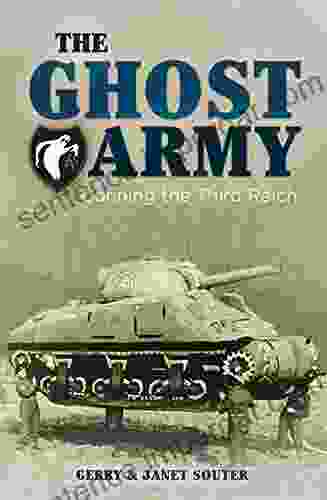Unveiling the Extraordinary Deception that Fooled Hitler's Forces
In the annals of military history, the Ghost Army stands as a testament to the power of deception and the ingenuity of human imagination. During World War II, a clandestine group of eccentrics, artists, engineers, and illusionists assembled to form a unique military unit with a mission to deceive the enemy. This extraordinary group became known as the Ghost Army.
The Birth of the Ghost Army
The idea for the Ghost Army originated in the fertile mind of Charles Ghost, a master of deception and camouflage. In 1944, as the war raged across Europe, Ghost proposed a daring plan to mislead the German army by creating an illusory force that would mimic the movements and tactics of regular combat units. The objective was to confuse and confound the enemy, diverting their attention from real Allied operations.
4.5 out of 5
| Language | : | English |
| File size | : | 5956 KB |
| Text-to-Speech | : | Enabled |
| Screen Reader | : | Supported |
| Enhanced typesetting | : | Enabled |
| Word Wise | : | Enabled |
| Print length | : | 226 pages |
| Lending | : | Enabled |
| Item Weight | : | 10.4 ounces |
| Dimensions | : | 5.5 x 8.5 inches |
Operational Deception: The Art of Trickery
The Ghost Army's modus operandi was based on the principles of operational deception. This strategy involves deploying deception measures to deceive an enemy about the true intentions, strength, or location of one's forces. The Ghost Army employed a wide range of techniques to achieve this, including:
* Inflatable Military Equipment: The Ghost Army possessed an arsenal of inflatable tanks, artillery pieces, and trucks. These replicas were remarkably lifelike, designed to fool aerial reconnaissance and ground observation. * Sonic Deception: The unit utilized a collection of loudspeakers and sound effects to simulate the sounds of marching troops, gunfire, and aircraft engines, creating the illusion of a large army on the move. * Radio Deception: Skilled radio operators in the Ghost Army sent out false transmissions, mimicking the communications of genuine military units, further confounding the enemy.
From Shadows to Success
The Ghost Army's deception tactics achieved remarkable success. German intelligence repeatedly fell for the unit's ruses, diverting troops and resources away from critical battlefronts. In the Vosges Mountains of France, the Ghost Army's inflatable tanks and trucks convinced the Germans that a massive Allied offensive was imminent, leading them to reinforce the area with six divisions.
Similarly, during the Battle of the Bulge, the Ghost Army's sonic deception created the illusion of an American force attacking from the south, forcing the Germans to leave their flank exposed, which was then exploited by the real Allied troops.
The Ghost Army's Secret Weapon: Deception and Camouflage
At the heart of the Ghost Army's success lay the masterful deception and camouflage techniques employed by its members. Artists such as William B. "Bill" Blass, later a renowned fashion designer, crafted realistic inflatable equipment that could deceive even experienced observers. Engineers and illusionists collaborated to create convincing smoke screens, sound effects, and radio transmissions that further reinforced the illusion of a real army.
Post-War Legacy: The Ghosts Fade into History
After the war, the Ghost Army's achievements remained largely unknown. The unit's operations were shrouded in secrecy, and its members were sworn to silence. Only in recent decades have the details of the Ghost Army's mission been fully revealed, allowing us to appreciate the extraordinary role it played in Allied victory.
Today, the Ghost Army's legacy serves as a reminder of the power of human ingenuity and the importance of deception in warfare. It is a story of creativity, courage, and the enduring human ability to outsmart the enemy through illusion and deception.


























































































